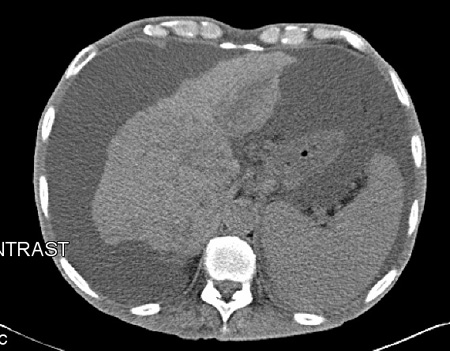Ascites is a pathologic collection of fluid in the peritoneal cavity. The most common cause is cirrhosis, which accounts for approximately 75% of cases, followed by congestive heart failure and malignant ascites.[1]Krige JEJ, Beckingham IJ. Clinical review: ABC of disease of liver, pancreas and biliary system. Portal hypertension-2. Ascites, encephalopathy and other conditions. BMJ. 2001 Feb 17;322(7283):416-8.
http://www.ncbi.nlm.nih.gov/pmc/articles/PMC1119638
http://www.ncbi.nlm.nih.gov/pubmed/11179165?tool=bestpractice.com
Clinical features
Patients present with abdominal distension; fluid may be detected on physical examination with shifting dullness. Ultrasound, computed tomography scan, or magnetic resonance imaging can confirm the diagnosis. In the majority of patients, history and examination will provide important clues as to the etiology of ascites (e.g., signs of chronic liver disease or cardiac failure). Causes include diseases that lead to portal hypertension, hypoalbuminemia, and neoplasms.
Cirrhosis
In 2017, cirrhosis caused more than 1.32 million deaths globally.[2]GBD 2017 Cirrhosis Collaborators. The global, regional, and national burden of cirrhosis by cause in 195 countries and territories, 1990-2017: a systematic analysis for the Global Burden of Disease Study 2017. Lancet Gastroenterol Hepatol. 2020 Mar;5(3):245-66.
https://www.ncbi.nlm.nih.gov/pmc/articles/PMC7026710
http://www.ncbi.nlm.nih.gov/pubmed/31981519?tool=bestpractice.com
Deaths due to cirrhosis constituted 2.4% of total deaths globally in 2017 compared with 1.9% in 1990.[2]GBD 2017 Cirrhosis Collaborators. The global, regional, and national burden of cirrhosis by cause in 195 countries and territories, 1990-2017: a systematic analysis for the Global Burden of Disease Study 2017. Lancet Gastroenterol Hepatol. 2020 Mar;5(3):245-66.
https://www.ncbi.nlm.nih.gov/pmc/articles/PMC7026710
http://www.ncbi.nlm.nih.gov/pubmed/31981519?tool=bestpractice.com
Chronic liver disease and cirrhosis account for approximately 2 million deaths annually worldwide.[3]Kim D, Bonham CA, Konyn P, et al. Mortality trends in chronic liver disease and cirrhosis in the United States, before and during COVID-19 pandemic. Clin Gastroenterol Hepatol. 2021 Dec;19(12):2664-66.e2.
https://pmc.ncbi.nlm.nih.gov/articles/PMC8271030
http://www.ncbi.nlm.nih.gov/pubmed/34256143?tool=bestpractice.com
In cirrhosis, development of hepatic fibrosis from chronic, recurrent hepatocyte injury leads to disruption in the intrahepatic circulation. This causes increased hepatic resistance to portal flow, resulting in the development of portal hypertension, and subsequent collateral vein formation and shunting of blood to the systemic circulation.[4]Ginès P, Cardenas A., Arroyo V, et al. Management of cirrhosis and ascites. N Engl J Med. 2004 Apr 15;350(16):1646-54.
http://www.ncbi.nlm.nih.gov/pubmed/15084697?tool=bestpractice.com
Ascites forms due to both renal dysfunction and the abnormalities in the portal and splanchnic circulation.[4]Ginès P, Cardenas A., Arroyo V, et al. Management of cirrhosis and ascites. N Engl J Med. 2004 Apr 15;350(16):1646-54.
http://www.ncbi.nlm.nih.gov/pubmed/15084697?tool=bestpractice.com
[5]Iwakiri Y. Pathophysiology of portal hypertension. Clin Liver Dis. 2014 May;18(2):281-91.
https://pmc.ncbi.nlm.nih.gov/articles/PMC3971388
http://www.ncbi.nlm.nih.gov/pubmed/24679494?tool=bestpractice.com
The chronic hepatic injury results in the release of nitric oxide, promoting splanchnic arterial vasodilation. This vasodilation causes activation of the renin angiotensin system, sympathetic nervous system, and antidiuretic hormone (ADH), to mitigate low circulatory volume. Release of ADH leads to retention of both sodium and water, resulting in the formation of ascites.[6]Alukal JJ, John S, Thuluvath PJ. Hyponatremia in cirrhosis: an update. Am J Gastroenterol. 2020 Nov;115(11):1775-85.
http://www.ncbi.nlm.nih.gov/pubmed/33156095?tool=bestpractice.com
Dilutional hyponatremia, arising from impaired renal excretion of free water, is a marker of more advanced liver disease.[1]Krige JEJ, Beckingham IJ. Clinical review: ABC of disease of liver, pancreas and biliary system. Portal hypertension-2. Ascites, encephalopathy and other conditions. BMJ. 2001 Feb 17;322(7283):416-8.
http://www.ncbi.nlm.nih.gov/pmc/articles/PMC1119638
http://www.ncbi.nlm.nih.gov/pubmed/11179165?tool=bestpractice.com
[7]Praharaj DL, Anand AC. Clinical implications, evaluation, and management of hyponatremia in cirrhosis. J Clin Exp Hepatol. 2022 Mar-Apr;12(2):575-94.
https://pmc.ncbi.nlm.nih.gov/articles/PMC9077240
http://www.ncbi.nlm.nih.gov/pubmed/35535075?tool=bestpractice.com
Portal hypertension facilitates cirrhosis decompensation, including ascites development.[8]Engelmann C, Clària J, Szabo G, et al. Pathophysiology of decompensated cirrhosis: portal hypertension, circulatory dysfunction, inflammation, metabolism and mitochondrial dysfunction. J Hepatol. 2021 Jul;75(suppl 1):S49-66.
https://pmc.ncbi.nlm.nih.gov/articles/PMC9272511
http://www.ncbi.nlm.nih.gov/pubmed/34039492?tool=bestpractice.com
[9]Iwakiri Y, Trebicka J. Portal hypertension in cirrhosis: pathophysiological mechanisms and therapy. JHEP Rep. 2021 Aug;3(4):100316.
https://pmc.ncbi.nlm.nih.gov/articles/PMC8318926
http://www.ncbi.nlm.nih.gov/pubmed/34337369?tool=bestpractice.com
Approximately 50% of patients with cirrhosis develop ascites within 10 years.[1]Krige JEJ, Beckingham IJ. Clinical review: ABC of disease of liver, pancreas and biliary system. Portal hypertension-2. Ascites, encephalopathy and other conditions. BMJ. 2001 Feb 17;322(7283):416-8.
http://www.ncbi.nlm.nih.gov/pmc/articles/PMC1119638
http://www.ncbi.nlm.nih.gov/pubmed/11179165?tool=bestpractice.com
[10]Sikuler E, Ackerman Z, Braun M, et al. Guidelines for diagnosis and management of cirrhotic ascites and its complications. The Israeli Association for the Study of the Liver [in Hebrew]. Harefuah. 2012 Dec;151(12):705-8.
http://www.ncbi.nlm.nih.gov/pubmed/23330265?tool=bestpractice.com
Patients with decompensated cirrhosis have a poor overall prognosis.[11]European Association for the Study of the Liver. EASL clinical practice guidelines for the management of patients with decompensated cirrhosis. J Hepatol. 2018 Aug;69(2):406-60.
https://www.journal-of-hepatology.eu/article/S0168-8278(18)31966-4/fulltext
http://www.ncbi.nlm.nih.gov/pubmed/29653741?tool=bestpractice.com
Other causes
Other causes of portal hypertension that may be associated with ascites include congestive heart failure, constrictive pericarditis, alcohol-related liver disease, fulminant hepatitis, subacute hepatitis, massive liver metastasis, and Budd-Chiari syndrome.
Conditions causing hypoalbuminemia such as nephrotic syndrome and protein-losing enteropathy may result in ascites. Peritoneal diseases including infectious peritonitis and malignancies can also cause ascites.

Inicie sesión o suscríbase para acceder a todo el BMJ Best Practice